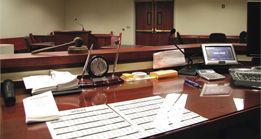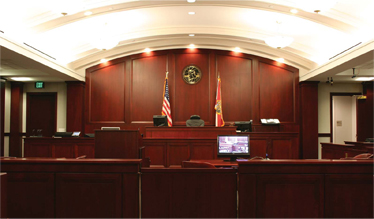Facilities Continue To Invest In Systems That Help Control Costs
One of the recurring themes of any sale is getting the customer to focus less on the initial price of a system, and more on the savings the technology will generate over the course of time. How challenging this is depends on both the client and the market in which they are operating, but an increasing number of public and private organizations are acknowledging that a significant up-front investment can contribute to boosting efficiencies—and therefore, decrease expenses—in a big way.
In the Clay County Courthouse in Florida the recording system must be extremely clear, so Astatic microphones were chosen for their sound quality and variable pattern design. in Topeka, KS. “A lot of that has to do with staff: most of the state funds are for staffing needs, and they are going to cut back on staff members.”
This has led to increased use of videoconferencing and video arraignment technologies, noted Ron Camden, vice president of North American sales at Biamp. “Courts used to spend a lot of money transporting a prisoner from a jail to a courtroom, and now that you can do that with video arraignment, you can save a tremendous amount of money,” he said.
MORE MASKING
A standard courtroom feature has been sound masking, and as the years have passed, noted Steve Young, vice president of sales and marketing at Atlas Sound, the technology has improved significantly. “There are better equalization settings, more zone outputs, and more feature options in general for courtroom applications,” he said. He pointed out that the Atlas ASP-MG24, for example, offers zone outputs for up to four dedicated, independent zones of sound masking, as well as auxiliary inputs that enable the same loudspeaker to be used for sound masking as well as public address. Up to 30 different pre-sets can be programmed into the system to accommodate for the attendance level in the courtroom on any given day.
MORE RECORDING
Courts are also demanding more sophisticated digital recording options. “The standard in recording is still four channels, and it has been for years,” Camden said. “There are too many people involved in the recording— there are too many microphones— to route all of it down into four channels.”

Smith Audio Visual implemented its Premium TouchDigital networkable digital recording system with AMX touchscreen control into 25 courtroom and hearing rooms for the Johnson County District Courts in Olathe, KS. With 1TouchDigital, all audio files are pushed off to the server automatically, so transcriptions can be easily done via any PC. and the recorder can be expanded to 24- channel recorder from the start,” he said. Each audio input can be recorded separately, and the interface was designed with flexibility in mind, enabling, Heilman explained, easy integration with existing sound reinforcement systems. The standard 1TouchDigital includes an eightchannel recorder and audio interface, while the Premium model features a seven-inch AMX touch screen offering one-touch start and recording as well as control over the whole room, enabling judges to mute any input, control volume, activate noise masking in the jury box and interface with videoconferencing functions.
In addition to the emphasis on more channels, Camden indicated that recording is now becoming centralized on a network. “It’s more cost effective to have a group of people that are monitoring the recording that is taking place in a number of courtrooms,” he said.
Young noted that the Atlas Varizone enables centralized recording and archiving, and operates either on its own GUI, or can be interfaced with AMX or Crestron control systems.
MORE TRANSLATION
While assistive listening has been a standard courtroom staple for many years, the market demand for translation technology is on the rise. “Before, in every courtroom we’d see assistive listening and at least one channel of interpretation,” said Cory Schaeffer, co-owner and vice president of sales and marketing at Listen Technologies. “Now, we are seeing multichannel interpretation.”
Features such as expanded language interpretation, especially systems that offer capabilities to translate from off site, are becoming more predominant as courts address the country’s multicultural landscape. “Some districts have interpreters on staff for the common language, but there are many courts that don’t have interpreters on staff,” Schaeffer said. “To be able to dial up interpretation or an unique language that they don’t have an interpreter for is a trend that we are going to see continue.”
Especially since in the case of video arraignment, remote language interpretation cuts costs considerably, Camden underlined. “If a translator can be at home with their handset, and with three different buttons they can control who they are talking to within the courtroom, they are more efficient, and the courtroom is more efficient because that person isn’t driving or flying to the court and sitting through a proceeding that might just be a hearing that lasts 10 or 20 minutes, and yet they are paid for the day.”










